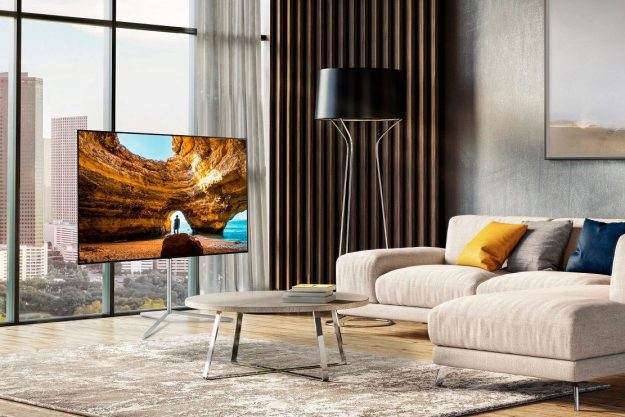If you need help getting started, look no further; our Epson Home Cinema 1450 projector unboxing and setup guide can painlessly walk you through the process. Keep reading for a quick walkthrough.
What’s in the box?
Of course, there’s the projector itself. Aside from that, you’ll find:
- A power cable
- A remote
- Product literature
…And that’s it! You won’t get any mounting equipment or external cables, including HDMI.
Hardware setup
The 1450 is absolutely loaded with connective ports, all located in the rear. To wit, you’ll find a LAN port, USB-A and USB-B, two HDMI ports (one of which supports MHL), three different VGA inputs, two 3.5mm audio inputs, mono audio out, and stereo audio out. If it’s compatible with projectors, it’s compatible with the HC1450.
To angle the projector correctly, there’s an adjustable kickstand on the bottom, and there’s a dual-purpose switch on top that covers the lens while simultaneously shutting down audio and video functions. Directly behind that switch, you’ll find a zoom/focus control knob (though the projector does have an autofocus feature).
Features and design
The 1450 utilizes Epson’s proprietary 3LCD technology, brightening the picture and making colors more vivid. It’s also got a built-in 16W speaker in case you need some soothing music to show off your vacation pictures.
There are onboard controls, but you’ll probably want to use the remote instead. It’s got all the usual functions — input selection, settings, etc. — but you can also use it as a presentation remote, flicking through slides and zooming in on areas of interest.
Software setup
Generally speaking, you won’t need to tweak the settings too much — out of the box, the HC1450 should be good to go in nearly any viewing environment. Still, we have some recommendations. If you’re in a brightly lit room or area, try heading to “Color Mode” in the settings and selecting “Bright Cinema.” If the room is darkened like a movie theater, try “Cinema” instead.
There’s also a “Game” mode, which reduces processing and input lag. If you’re concerned about energy use (or about the lifespan of your projection lamp), try turning on Eco mode, located under “Power Consumption”. It’ll dim the screen a bit, though, so be careful.
Editors' Recommendations
- Best 4K projectors for 2024
- Epson Home Cinema LS11000: $3999 for 4K, HDR projection
- Optoma’s CinemaX P2 short throw 4K projector has a built-in soundbar



